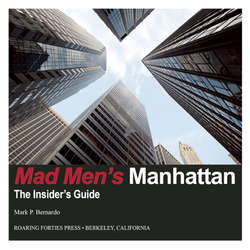Mad Men's Manhattan

Реклама. ООО «ЛитРес», ИНН: 7719571260.
Оглавление
Mark P. Bernardo. Mad Men's Manhattan
Contents
Introduction
1. Competitors and Clients
McCann-Erickson
Grey Advertising
Doyle Dane Bernbach
Young and Rubicam
Bloomingdale’s
Henri Bendel
Saks Fifth Avenue
Penn Station and Madison Square Garden
2. Restaurants
Toots Shor’s
Lutèce
La Grenouille
Sardi’s
Keen’s Steakhouse
The Four Seasons
Frank O’Connor’s Favorite Bistro
3. Bars, Clubs, and Nightlife
The Lenox Lounge
El Morocco
The Slipper Room
P. J. Clarke’s
The Gaslight Café and Greenwich Village
Chumley’s
Grand Central Oyster Bar
The Broadhurst Theatre
The Stork Club
The University Club
Two More for the Road
4. Hotels
The St. Regis
The Roosevelt
The Savoy Plaza and Grand Army Plaza
The Waldorf-Astoria
The Taj Pierre
The Hotel Elysée
More Grande Dames
About the Author
About Roaring Forties Press
Отрывок из книги
Introduction
Map: Sites that Play a Role in Mad Men
.....
One thing for a prospective Mad Men tourist to keep in mind is that only the pilot episode shot its interiors in New York; the rest used locations in and around Los Angeles to substitute for the actual sites. Sites are in bold; the sites with numbers preceding them appear on the map. Weiner and his crew have done an outstanding job recreating the feel of 1960s Manhattan, but aside from the sites mentioned in the pilot (Lennox Lounge, Slipper Room), the venues may look a bit different than they do on TV. And, of course, smoking is a no-no unless otherwise indicated. It isn’t the 1960s anymore.
This theme develops in how the young lions of Sterling Cooper—Harry Crane, Ken Cosgrove, Paul Kinsey, and Peggy Olson— approach their work under the tutelage of the older, but forward-thinking, Don Draper. Don himself seems to invite comparisons to Bill Bernbach, widely regarded as the ad industry’s most influential figure of the twentieth century. Bernbach, like Don, was a creative visionary who approached his work with a hint of arrogance. Also like Don, Bernbach presented himself as a conservative, old school “square” among increasingly younger, more hip coworkers and subordinates, but was widely regarded as the engine that made the creative department run. One could imagine some of Bernbach’s famous quotations about the business coming from the mouth of Don Draper. “Rules are what the artist breaks,” he said. “The memorable never emerged from a formula.” He warned, “Logic and over-analysis can immobilize and sterilize an idea. It’s like love—the more you analyze it, the faster it disappears.”
.....